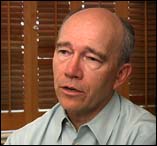|
Introduction by
Sam Abell
When I imagined
photography what I saw were photographs. If I imagined the process of
photography at all it was pleasantly. But the reality of fieldwork woke
me from that reverie. Seeking the picture is the complex process that
dominates documentary photography, and in the seeking there is often
a story. The story varies. At its best it is magical; at its worst it
is bitterly frustrating - you see the picture, but can't get to it.
That was the situation of the most important picture of my first magazine
assignment in Newfoundland. The traditional maritime way of life was
coming to an end and the government was relocation many of the small
isolated outports. There were tales of entire fishing villages tugged
by barges along the coast in summer, but I never saw any dwellings being
moved despite an all out effort. So I reluctantly gave up on this picture
possibility.
 Months
later I was flying to Little Bay Islands.. It was a scheduled, full
flight in a plane outfitted with skis. As we approached the island I
saw two distinct lines of men pulling a house across the ice. I immediately
saw the picture I had been seeking: It was a concentrated composition
of men, the house and the ice - nothing else. I had to have it. Months
later I was flying to Little Bay Islands.. It was a scheduled, full
flight in a plane outfitted with skis. As we approached the island I
saw two distinct lines of men pulling a house across the ice. I immediately
saw the picture I had been seeking: It was a concentrated composition
of men, the house and the ice - nothing else. I had to have it.
I bolted into the cockpit and shouted for the pilots to help me. They
were startled but heard me out. Over the roar of the engines I yelled
that we needed to go back and fly over the ice - or could they land
and let me out? The pilots shrugged and, to the amazement of the other
passengers, began turning the heavy plane around. They flew back and
made a slow circle of the scene. But too much time had passed. The strong
lines of men had broken up. And we were still too high. Back at my seat
I pressed my camera against the weathered glass and took a photograph
anyway. For thirty years I never looked at it. It was too painful.
But now I find it curiously interesting in its inclusiveness. It reminds
me of the beginning of a lifetime of seeking the picture.
|

 Months
later I was flying to Little Bay Islands.. It was a scheduled, full
flight in a plane outfitted with skis. As we approached the island I
saw two distinct lines of men pulling a house across the ice. I immediately
saw the picture I had been seeking: It was a concentrated composition
of men, the house and the ice - nothing else. I had to have it.
Months
later I was flying to Little Bay Islands.. It was a scheduled, full
flight in a plane outfitted with skis. As we approached the island I
saw two distinct lines of men pulling a house across the ice. I immediately
saw the picture I had been seeking: It was a concentrated composition
of men, the house and the ice - nothing else. I had to have it.